Daily Current Affairs for UPSC 30th Oct 2025


| Index |
| S.No | Topic | Page No |
| Daily Hindu Analysis (YouTube) |
| 1. | How do cyclones form and how are they measured? |
|
| 2. | The Indus conundrum: when water is both a lifeline and a Faultline |
|
| 3. | Indian maritime sector has seen historic progress: Modi |
|
| 4. | IT industry a major contributor to carbon footprint, report finds |
|
| 5. | Study reveals rare defence traits in Indian frogs |
|
| 6. | Sugar sector concerned over reduction in ethanol sourcing |
|
| Daily Current Affairs (App) |
| 7. | Rehabilitation Council of India |
|
| 8. | Tourism Boost Vision 2029: Transforming 50 Domestic Destinations into World-Class Attractions |
|
| 9. | SBSTTA-27 Meeting under Convention on Biological Diversity Ends Without Consensus |
|
| 10. | Justice Surya Kant Recommended as the 53rd Chief Justice of India |
|
How do cyclones form and how are they measured?
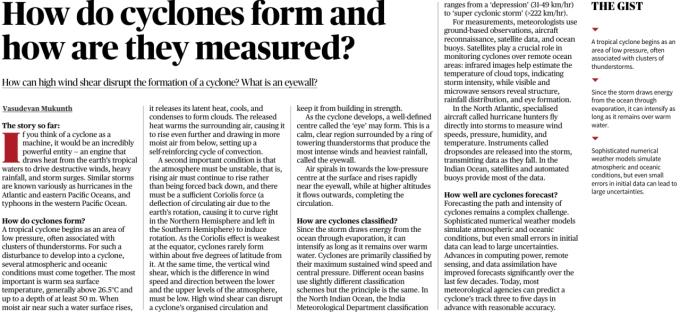
GS Paper: GS-I – Geography | Physical Geography | Climatology Context: Cyclones are among the most powerful and destructive natural phenomena on Earth. As India frequently faces tropical cyclones in the Bay of Bengal and the Arabian Sea, understanding their formation, classification, and measurement is crucial for disaster preparedness and mitigation. The article explains how cyclones originate, what sustains them, and the scientific methods used to monitor and forecast their intensity.
What Are Cyclones?
A tropical cyclone is a rapidly rotating storm system characterized by a low-pressure centre, strong winds, and heavy rain. Depending on the region, they are called:
- Hurricanes – Atlantic and Eastern Pacific Oceans
- Typhoons – Western Pacific Ocean
- Cyclones – Indian Ocean
Cyclones act like heat engines — drawing energy from
warm tropical waters through evaporation and condensation, which fuels their destructive power.
How Do Cyclones Form? Several atmospheric and oceanic conditions must coincide:
1. Warm Ocean Waters: o Sea surface temperature above 26.5°C extending to a depth of at least 50 m provides the energy source. o As moist air rises from warm waters, it cools and condenses, releasing latent heat that further warms the surrounding air and triggers a cycle of convection.
2. Coriolis Force: o Required to initiate rotation; absent near the equator, hence cyclones rarely form within 5° latitude of it.
3. Low Vertical Wind Shear: o A large difference in wind speed or direction between lower and upper atmosphere layers can disrupt the storm’s organization, preventing cyclone formation.
4. Unstable Atmosphere: o Rising air must not be forced back down — instability promotes vertical convection necessary for cyclone growth. As these factors combine, air spirals inward to the low-pressure centre, rises rapidly, and forms a well-defined eye — a calm region encircled by the eyewall, where winds and rainfall are most intense.
Cyclone Classification: Cyclones are categorized based on maximum sustained wind speed and central pressure.
- In India, the India Meteorological Department (IMD) classifies them from “Depression” (31–49 km/h) to “Super Cyclonic Storm” (>222 km/h).
- Other basins use similar systems — for example, the Saffir-Simpson Hurricane Scale in the Atlantic.
How Are Cyclones Measured? Modern meteorology relies on multiple technologies for real-time monitoring:
1. Satellites: o Use infrared imagery to estimate cloud-top temperature, indicating storm intensity. o Visible and microwave sensors reveal structure, rainfall distribution, and eye formation.
2. Aircraft Reconnaissance: o In the North Atlantic, “Hurricane Hunters” fly into storms to measure wind speeds, pressure, and humidity using dropsondes that transmit data as they fall.
3. Buoys and Ground Stations: o Automated ocean buoys track sea surface temperature, wind velocity, and pressure variations — vital for Indian Ocean forecasting.
4. Numerical Weather Models: o Sophisticated models simulate atmospheric and oceanic dynamics to predict a cyclone’s path and intensity, though small errors in data can cause large uncertainties. Challenges in Prediction: Despite advancements in computing power, satellite imaging, and remote sensing, forecasting cyclone intensity and landfall remains difficult.
- Slight inaccuracies in initial data (e.g., sea-surface temperature or humidity levels) can cause significant deviations in predicted tracks.
- The IMD and global agencies can now forecast cyclones up to 3–5 days in advance with reasonable accuracy — yet, last-minute intensity changes still challenge disaster management efforts.
Analysis & Significance for India: - India’s long coastline and dense population make cyclone prediction and preparedness vital for saving lives and property.
- The use of early-warning systems, satellite data integration, and community-based preparedness have significantly reduced cyclone-related fatalities in recent years.
- However, climate change has led to warmer oceans and slower-moving cyclones, increasing both frequency and intensity, especially over the Bay of Bengal.
UPSC Mains: Q. Explain the key atmospheric and oceanic conditions necessary for cyclone formation. How do modern technologies assist in measuring and forecasting cyclones?
The Indus conundrum: when water is both a lifeline and a Faultline
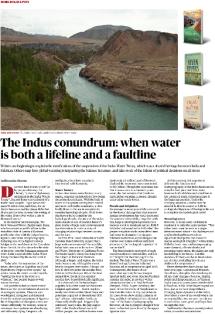
GS Paper: GS-II – International Relations | GS-I – Geography (River Systems) | GS-III – Environment
Context: The Indus River, one of Asia’s greatest transboundary rivers, has once again come under geopolitical and ecological scrutiny. The discussion has been reignited by the suspension and re-evaluation of the Indus Waters Treaty (IWT) — a landmark 1960 agreement between India and Pakistan mediated by the World Bank.
Writers and experts now highlight that climate change, melting glaciers, and unsustainable human intervention are disrupting the river’s natural rhythm — turning a lifeline into a potential faultline in South Asia’s fragile ecology and diplomacy.
About the Indus River and the Treaty:
- The Indus River originates near Lake Mansarovar in Tibet and flows through India (Ladakh, Jammu & Kashmir, Punjab) before entering Pakistan and draining into the Arabian Sea.
- The Indus Waters Treaty (1960) divided the river system’s six major rivers:
- Eastern Rivers (Ravi, Beas, Sutlej): Allocated to India.
- Western Rivers (Indus, Jhelum, Chenab): Allocated to Pakistan, with limited Indian rights for non-consumptive use (e.g., hydroelectricity).
- The IWT is often hailed as one of the most successful water-sharing arrangements globally, even surviving wars and political crises.
Key Concerns and the Present Conundrum: 1. Political & Diplomatic Dimension:
- The suspension of the IWT’s regular meetings and India’s calls to renegotiate terms post-Uri and Pulwama attacks have strained bilateral water diplomacy.
- The treaty, once a symbol of cooperation, now risks becoming a tool of political leverage, especially as water scarcity deepens.
2. Environmental and Climatic Challenges: - Global warming has accelerated Himalayan glacier melt, threatening long-term water availability in the Indus basin.
- Extreme weather — flash floods, erratic monsoons, and glacial lake outburst floods (GLOFs) — is altering river flow patterns.
- Floods in the Indus basin, such as Pakistan’s catastrophic 2022 floods, highlighted how human interventions (embankments, large dams, and irrigation canals) amplify rather than mitigate risks.
3. Human and Developmental Impact: - Overdependence on large-scale irrigation projects has led to ecological degradation — waterlogging, salinization, and biodiversity loss.
- Urbanization and industrial water use in both countries have intensified competition between agriculture, industry, and ecology.
- Writers argue that the Indus is being over-engineered, forcing it away from its natural course, undermining its ecological purpose.
4. A Shared Heritage under Threat: - The Indus is not merely a geopolitical asset but also a cultural and civilizational artery, sustaining millions for millennia.
- Literary works like “The Dark Coloured Waters” and “Trial by Water” remind us that the river’s history is intertwined with human survival and identity — from ancient Sindhu civilizations to modern border disputes.
Analysis: 1. Hydro-diplomacy in Crisis:
The IWT’s spirit of cooperation is being overshadowed by nationalistic politics and strategic distrust. As India strengthens infrastructure in J&K, Pakistan views it as a threat to its water security.
2. Climate Change as a Threat Multiplier:
Both nations face common hydrological stress — melting glaciers, unpredictable flows, and population pressures — demanding collaborative adaptation strategies rather than competition.
3. Ecological Rebalancing Needed:
The focus must shift from building more dams to restoring the natural hydrology — protecting wetlands, floodplains, and groundwater recharge zones.
4. Need for a Basin-Wide Approach:
Instead of treating rivers as national assets, they must be viewed as shared ecosystems requiring integrated basin management across borders.
UPSC Mains: Q. Discuss how climate change and political tensions have transformed the Indus River from a shared lifeline into a potential faultline between India and Pakistan. Suggest measures for sustainable transboundary river governance.
Indian maritime sector has seen historic progress: Modi
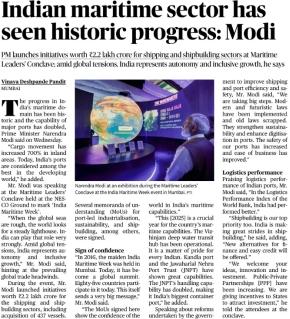
GS Paper: GS-III – Infrastructure, Ports, Shipping, and Industrial Development
Context: Prime Minister Narendra Modi, at the Maritime Leaders’ Conclave during India Maritime Week, announced initiatives worth ₹2.2 lakh crore for strengthening India’s shipping and shipbuilding sectors. He emphasized India’s transformation into a global maritime power amid global economic headwinds, focusing on port-led industrialisation, sustainability, and logistics efficiency.
What is it About?
India’s maritime sector has witnessed historic progress, with:
- Cargo movement increasing by 700% in inland waterways,
- Doubling of port handling capacity, and
- Major reforms to enhance efficiency, safety, and digitalisation in ports.
Several Memoranda of Understanding (MoUs) were signed at the conclave, targeting port-led growth, sustainable shipbuilding, and global partnerships in maritime technology and logistics.
Analysis:
1. Strategic Significance:
- The maritime sector contributes nearly 95% of India’s trade by volume and 70% by value.
- Initiatives under the Sagarmala and Maritime India Vision 2030 focus on modernising ports, developing shipyards, and expanding inland waterways.
- The operationalisation of Vizhinjam Deep Water Transshipment Port and expansion of JNPT (Jawaharlal Nehru Port Trust) reflect India’s growing logistical strength.
2. Economic and Environmental Impact: - The sector supports employment, exports, and the Blue Economy, aligning with India’s Amrit Kaal Vision 2047.
- The emphasis on green and digital ports and PPP models reflects India’s push for sustainable development.
3. Global Leadership & Diplomacy: · India’s maritime engagement with global partners—especially under Indo-Pacific cooperation frameworks—enhances its strategic autonomy. · Through sustainable and inclusive policies, India aims to position itself as a regional logistics hub competing with global maritime powers.
UPSC Prelims Match the following major Indian ports with their respective key features:
| List I (Port) | List II (Feature/Fact) |
| A. Jawaharlal Nehru Port (JNPT) | 1. India’s first deep-water transshipment port |
| B. Vizhinjam Port | 2. India’s largest container port |
| C. Kandla Port (Deendayal Port) | 3. India’s major port on the western coast handling crude and fertilizers |
| D. Paradip Port | 4. First major port on the eastern coast developed post-Independence |
Options:
(a) A-2, B-1, C-3, D-4
(b) A-1, B-2, C-4, D-3
(c) A-3, B-4, C-2, D-1
(d) A-2, B-3, C-1, D-4
Answer: (a) A-2, B-1, C-3, D-4
IT industry a major contributor to carbon footprint, report finds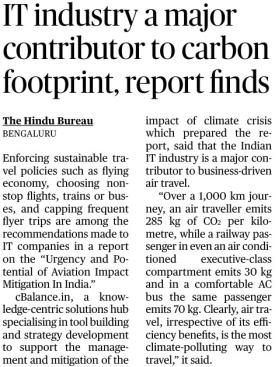
GS Paper III – Environment, Ecology & Sustainable Development Context A recent report titled “Urgency and Potential of Aviation Impact Mitigation in India” by cBalance.in, a sustainability research organization, has highlighted the significant role of India’s IT industry in driving up carbon emissions through frequent business-related air travel. The report calls for sustainable travel policies within the IT sector to reduce its environmental impact and contribute to India’s net-zero emission goals.
About the Report
- It compared carbon emissions across different transport modes:
- Air travel: 285 kg of CO₂ per passenger over 1,000 km.
- Rail (executive class): 30 kg CO₂ for the same distance.
- AC bus: 70 kg CO₂.
- Clearly, air travel produces the highest emissions, making it the most climate-polluting way to travel.
Analysis - The IT and software services sector is one of India’s largest corporate employers with extensive global client networks.
- Frequent international and domestic travel for client meetings, project deployments, and conferences has expanded its carbon footprint.
Sustainability Challenge - Despite digitalization and remote working trends post-pandemic, corporate air travel remains high.
- The report urges companies to adopt carbon-neutral travel policies, such as:
- Limiting unnecessary flights.
- Choosing non-stop routes or alternative transport (train/bus).
- Capping frequent flyer programs that encourage more travel.
UPSC Prelims Q. Which of the following statements is correct as per the recent report
“Urgency and Potential of Aviation Impact Mitigation in India”? 1. Air travel is the least polluting mode of transport for business purposes. 2. The IT industry is a major contributor to carbon emissions through business-driven air travel. 3. The report was prepared by the Ministry of Environment, Forest and Climate Change. Options:
(a) 1 and 2 only
(b) 2 only
(c) 2 and 3 only
(d) 1 and 3 only
Answer: (b) 2 only
Study reveals rare defence traits in Indian frogs
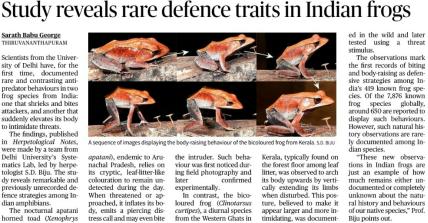
GSIII – Environment & Biodiversity: Conservation of species and ecosystems, Biodiversity hotspots in India, Role of scientific research in wildlife protection, Environmental impact and ecological balance
Context Scientists from the University of Delhi’s Systematics Lab, led by renowned herpetologist Dr. S.D. Biju, have documented rare anti-predator defence behaviours in two frog species from India — the Apatani horned toad (Xenophrys apatani) and the bicoloured frog (Clinotarsus curtipes).
This marks the first recorded observation of such defensive strategies among India’s frog species, contributing significantly to understanding amphibian behavioural ecology.
About the Discovery
- The findings were published in Herpetological Notes, highlighting contrasting defence mechanisms in the two species:
1. Apatani horned toad (
Xenophrys apatani) – Endemic to Arunachal Pradesh, it uses camouflage to blend with leaf litter. When threatened, it inflates its body, emits a piercing distress call, and may bite attackers. 2. Bicoloured frog (
Clinotarsus curtipes) – Found in Western Ghats, it exhibits a unique body-raising behaviour, elevating its limbs to appear larger and intimidate predators.
- These behaviours were first noticed during field photography and later confirmed experimentally in the wild.
Scientific Significance and Analysis - Of the 7,876 known frog species globally, about 650 are known to exhibit such defensive strategies, but this is the first documentation among India’s 419 frog species.
- The findings underscore that India’s amphibian diversity — though vast — remains poorly studied in terms of behavioural ecology and evolutionary adaptations.
- Such research is critical because amphibians serve as bioindicators of environmental health, and their defence mechanisms can offer insights into evolutionary survival strategies.
UPSC Prelims Q. Consider the following statements about the recently documented frog species in India: 1. The
Apatani horned toad is endemic to the Western Ghats and exhibits body-raising behaviour as a defence mechanism. 2. The
Bicoloured frog from Kerala exhibits biting and shrieking as its primary defence strategy. 3. The observations mark the first recorded instances of such defensive behaviours among Indian amphibians. Which of the above statements is/are correct?
(a) 1 and 2 only
(b) 2 and 3 only
(c) 3 only
(d) 1, 2 and 3
Answer: (c) 3 only
Sugar sector concerned over reduction in ethanol sourcing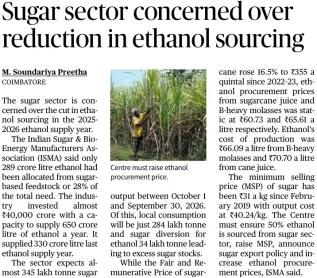
GS-III – Indian Economy, Agriculture, Energy & Infrastructure
Context: The Indian Sugar and Bio-Energy Manufacturers Association (ISMA) has raised concerns over the government’s decision to cut ethanol sourcing from sugar-based feedstock for the 2025–26 supply year. The reduction could lead to an excess sugar stockpile, affecting both the sugar industry’s profitability and India’s ethanol blending targets under its clean energy goals. About the Issue:
- The government has allocated only 289 crore litres of ethanol from sugar-based feedstock — about 28% of total ethanol requirement, compared to higher allocations in previous years.
- The sugar industry, having invested ₹40,000 crore in ethanol production capacity, argues this cut could lead to overproduction of sugar and financial strain.
- The government’s target is to achieve 20% ethanol blending with petrol by 2025, under the National Policy on Biofuels (2018).
Analysis: 1. Economic Implications: - Reduced ethanol offtake limits the industry’s ability to divert sugar for biofuel, increasing sugar surplus and putting downward pressure on prices.
- With high Fair and Remunerative Price (FRP) of sugarcane and stagnant ethanol procurement prices, mills may face cost-revenue imbalance, affecting timely payments to farmers.
2. Energy & Environment Link: - Ethanol blending helps reduce oil imports, improve energy security, and cut greenhouse gas emissions.
- The cut in ethanol procurement may delay India’s E20 blending goal, impacting its clean fuel transition strategy.
3. Policy Dimensions: - The move reflects a possible policy recalibration to manage food vs. fuel balance amid fluctuating global sugar and fuel prices.
- Experts recommend raising ethanol procurement prices, diversifying feedstock sources (e.g., maize, damaged grains), and stabilizing long-term ethanol policy to ensure predictable investment returns.
UPSC Prelims: Q. Consider the following statements about India’s Ethanol Blending Programme (EBP): 1. The National Policy on Biofuels (2018) targets 20% blending of ethanol with petrol by 2025. 2. Ethanol can be produced only from sugarcane-based feedstock in India. 3. Ethanol blending helps in reducing India’s crude oil import dependence. Which of the above statements is/are correct?
(a) 1 and 3 only
(b) 2 and 3 only
(c) 1 only
(d) 1, 2 and 3
Answer: (a) 1 and 3 only
Rehabilitation Council of India
Syllabus: GS Paper II – Social Justice & Empowerment (Welfare of Persons with Disabilities)
Context: The Rehabilitation Council of India (RCI) — statutory regulator for rehabilitation and special education — has announced broad reforms to improve transparency, efficiency and inclusivity across India’s disability-service ecosystem.
Key Points
- Established: Began as a registered society in 1986; the RCI Act was enacted in 1992 and RCI became a statutory body on 22 June 1993.
- Nodal Ministry: Operates under the Ministry of Social Justice & Empowerment.
- Mandate: To regulate and monitor services for persons with disabilities and to standardise training and practice.
- Central Rehabilitation Register: RCI maintains a central register of all qualified rehabilitation and special-education professionals.
- Standards of Training: Prescribes minimum standards of education and training for professionals working with persons with disabilities.
- 16 Professional Categories: RCI allocates and prescribes standards for 16 categories of rehabilitation and special-education personnel.
- Recognition Role: Recognises national and apex disability institutes as manpower-development centres.
- Training Policy: Regulates curricula and training programmes to ensure uniform quality and competency of personnel.
- Regulatory Functions: Monitors compliance, conducts inspections, and can de-register or take corrective action to maintain standards.
- Reforms Focus: Recent reforms emphasize greater transparency in registration, streamlined procedures for recognition and renewal, and measures to widen access and inclusion.
- Outcome Aim: Seeks to strengthen the skill-pool, improve service delivery for persons with disabilities, and ensure standardized rehabilitation across states.
Source: PIB
Tourism Boost Vision 2029: Transforming 50 Domestic Destinations into World-Class Attractions
Syllabus: GS Paper III – Economy (Tourism Sector Development & Infrastructure) Context: The Government of India has launched an ambitious initiative to develop 50 domestic tourist destinations into world-class attractions by 2029, aiming to enhance India’s global tourism profile through sustainable, inclusive, and culturally rich development.
Key Points
- Objective: To transform 50 selected tourist destinations into globally competitive sites showcasing India’s cultural, natural, and historical richness.
- Timeline: To be achieved by 2029 under the “Tourism Boost Vision 2029.”
- Approach: Focuses on sustainability, accessibility, and visitor engagement through modern infrastructure and authentic cultural experiences.
- State Involvement: Each state and union territory will propose potential sites within a month; at least one flagship destination will be developed in every region.
- Geographical Diversity: Includes destinations from Kashmir’s valleys, Kerala’s backwaters, Gujarat’s coastlines, and Assam’s hills, reflecting India’s regional variety.
- Strategic Vision: Seeks to convert India’s cultural and natural wealth into global tourism assets, promoting self-reliance (Atmanirbhar Bharat) and heritage-based growth.
- Economic Impact: Expected to generate large-scale employment, support local artisans and small businesses, and boost the hospitality sector.
- Investment: Encourages foreign and domestic investment in tourism infrastructure with emphasis on environmental and cultural preservation.
- Outcome Goal: To create a unified, world-class tourism network that enhances India’s soft power, economic growth, and global appeal.
Source: The Hindu / PIB
SBSTTA-27 Meeting under Convention on Biological Diversity Ends Without Consensus
Syllabus: GS Paper III – Environment & Ecology (Biodiversity Conservation; International Environmental Agreements) Context: The 27th meeting of the Subsidiary Body for Scientific, Technical and Technological Advice (SBSTTA-27) under the Convention on Biological Diversity (CBD) concluded in Panama on 24 October 2025 without consensus on key recommendations for the upcoming COP17 in Yerevan, Armenia.
Key Points
- About SBSTTA: It is a subsidiary body under the CBD, responsible for providing scientific and technical advice to guide implementation of biodiversity commitments.
- Participation: Nearly 800 delegates attended SBSTTA-27, representing governments, scientific bodies, and international organizations.
- Objective: To prepare recommendations for monitoring and assessing progress in implementing the Kunming-Montreal Global Biodiversity Framework (KMGBF).
- Outcome: The meeting ended without consensus, as many parts of the text remained bracketed (indicating disagreement).
- Main Challenge: Divergence among parties on methods for tracking and reporting biodiversity progress and defining global indicators.
- Significance: Raises concerns since only five years remain to achieve the 2030 biodiversity targets set under the KMGBF.
- Discussion Focus Areas:
- Review of the first global progress report on the KMGBF.
- Evaluation of 23 global biodiversity targets.
- Frameworks for national biodiversity plans and progress indicators.
- Inclusion of developing countries, indigenous peoples, women, and youth in biodiversity monitoring.
- Next Step: These unresolved issues will now be taken up at COP17, where member nations will attempt to finalize the monitoring framework.
Source: The Hindu
Justice Surya Kant Recommended as the 53rd Chief Justice of India
Syllabus: GS Paper II – Polity & Governance (Judiciary; Constitutional Provisions) Context Justice Surya Kant, currently the second senior-most judge of the Supreme Court, has been recommended by outgoing CJI B.R. Gavai as his successor. The formal communication has been sent to the Union Government, paving the way for his appointment as the 53rd Chief Justice of India.
Justice Kant’s tenure will begin on
24 November 2025, following the
retirement of CJI Gavai.
Constitutional and Procedural Framework Constitutional Basis - Article 124(2) of the Constitution empowers the President of India to appoint the Chief Justice of India and other judges of the Supreme Court.
- The CJI holds office until the age of 65 years.
Eligibility Criteria A person must:
- Be a citizen of India; and
- Have served as a Judge of a High Court for at least five years, or
- Been an advocate of a High Court for at least ten years, or
- Be considered by the President as a distinguished jurist.
Appointment Procedure of the Chief Justice of India 1. Recommendation by the Outgoing CJI:
o As per the
Memorandum of Procedure (MoP), about a month before retirement, the
Law Minister seeks the recommendation of the
incumbent CJI for their successor.
o The outgoing CJI recommends the
senior-most judge of the Supreme Court deemed fit for the position.
2.
Government’s Role:
o The
Union Minister of Law and Justice forwards the recommendation to the
Prime Minister, who in turn advises the
President to make the appointment.
3.
Seniority Convention:
o The appointment of the
senior-most judge ensures
continuity, stability, and institutional integrity.
o This convention has been upheld by judicial precedents, including the
Second Judges Case (1993), which strengthened the
Collegium System.
4.
Oath of Office:
o The
President of India administers the oath of office to the new Chief Justice of India.
5.
Acting CJI:
o Under
Article 126, the President may appoint an
Acting CJI when the office is vacant or the CJI is unable to perform duties.
Collegium System - A judicial body responsible for the appointment and transfer of judges to the Supreme Court and High Courts.
- For Supreme Court appointments, it consists of the CJI and the four senior-most judges.
- Institutionalized through judicial interpretation, particularly the Third Judges Case (1998), following the earlier Second Judges Case (1993).
- Ensures judicial independence by limiting executive interference.
Memorandum of Procedure (MoP) - A framework agreed upon between the judiciary and the executive after the striking down of the NJAC (National Judicial Appointments Commission) by the Supreme Court.
- It prescribes:
- Criteria for selection: experience, integrity, representation, and temperament.
- Transparency and accountability in recommendations.
- Reasons to be provided by the government if a recommendation is returned or delayed.
Tenure and Removal - No fixed tenure; serves until 65 years of age.
- Removal under Article 124(4) by the President, after a special majority resolution by Parliament, on grounds of proven misbehaviour or incapacity.
Role and Powers of the Chief Justice of India - Judicial Role:
- Allocates cases and constitutes benches.
- Presides over Constitution Benches and matters of national importance.
- Administrative Role:
- Heads the Supreme Court administration, including staff and case management.
- Appoints ad hoc judges under Article 127.
- Collegium Leadership:
- Leads the judicial appointments and transfers to SC and HCs.
- Ceremonial Role:
- Administers the oath of office to the President of India.
- Despite being the head of the judiciary, the CJI remains “first among equals” — decisions in the Court are collegial and consensus-based.
Significance Justice Surya Kant’s appointment will ensure
continuity of judicial leadership and uphold the
seniority-based convention, reinforcing faith in the
independence and stability of India’s judiciary.








